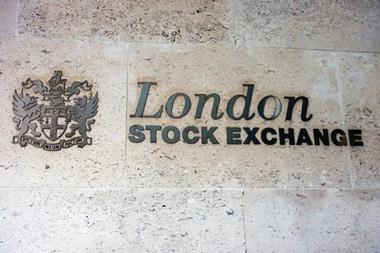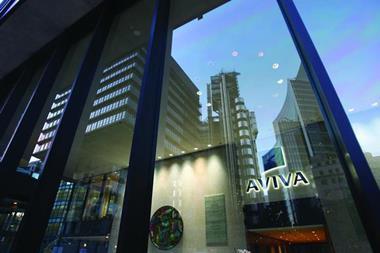Doubts remain over the robustness of Aviva’s finances, despite its better than expected first quarter results. Angelique Ruzicka talks to chief executive Igal Mayer and assesses market reaction
Has Aviva got what it takes? Doubts have been swirling around the company for months over whether it has sufficient capital to meet its 2009 dividend pledge. Concern peaked in March, when it said it would maintain its 2008 dividend – investors feared the payout would put too much pressure on its capital position. Its shares fell 30% as a result (see chart).
But the insurer has surprised analysts by announcing surplus capital of £2.5bn in its first quarter results, despite market predictions that the surplus would be no more than £2bn.
Aviva is poised to pay its 2008 dividend on 15 May at a cost of £0.3bn (in cash). Its interim results and second quarter figures for new business in long-term savings, to be announced on 6 August, should then reveal its policy on its 2009 dividend.
Igal Mayer, chief executive of Norwich Union Insurance (soon to be Aviva after a controverisal multimillion pound rebranding), will not be drawn into confirming that the 2009 dividend is safe. “You wouldn’t expect us to speculate on what the interim dividend will be at this stage of the year. That’s something we’ll consider in the usual way at interim results,” he says. “We’ll take account of the same considerations as always: our operating results, the overall results and our capital position.”
Aviva boosted its Insurance Group Directive (IGD) capital in several ways. It derived some of the money from the ongoing profits of the group, through issuing hybrid capital (subordinated debt), and through take up of the “scrip” dividend – shareholders were offered the option of being paid in shares rather than cash. This move has reduced the capital cost of the dividend payout by £0.2bn.
“We are confident that the strength of our balance sheet means that Aviva is in good shape to prosper in the current economic climate,” says Mayer.
The boost to its capital has calmed concerns that the insurer would be forced to enter into a rights issue. “The capital position was higher than we had been expecting. It gives Aviva flexibility not to be in such a rush to raise new money,” says Barrie Cornes, equity analyst at Panmure Gordon & Co.
Mayer maintains that the company has no plans for a rights issue. “Our balance sheet remains strong and of a high quality,” he says. “We are actively managing our capital and proactively managing balance sheet risk.”
Yet concerns remain. One analyst, who refuses to be named, says the quality of solvency capital is still an issue. “There are two aspects to the Aviva situation. One is that solvency was low; now it just looks less low and it is off the critical list. The second is the quality of its solvency capital because some of it is borrowed. So Aviva is not quite as rich as it says it is.”
Cornes believes the pressure is still on to raise capital in the future: “The FSA may increase hurdle rates, so it may have to enter into a rights issue,” he says.
Aviva’s capital position is not the only issue to come into question. Credit rating agency Moody’s has put the insurer under review for a downgrade pending an investigation into its investment strategy. It is currently rated AA3 (excellent).
Paul Oates, a Moody’s analyst, says: “We want to look into the equity exposures, the corporate mortgage portfolio exposures, and understand the level of provisions the company has made, how conservative they are and what the likely impact would be on capital levels if there is further deterioration of these assets.”
Other analysts are scrutinising Aviva’s mortgage and corporate debt exposure. Blair Stuart, an analyst at Merrill Lynch, says: “There have been no commercial real estate loan defaults in the first quarter. Longer term concerns on asset risk, particularly commercial real estate, will persist. But our view on the company’s ability to earn and restructure its way around such losses has improved.”
Meanwhile, Standard & Poor’s ratings of Aviva’s main operating subsidiaries are AA- (very strong) with a negative outlook, while AM Best’s ratings of the main operating subsidiaries are A (excellent) with a stable outlook. Fitch downgraded Aviva from A+ on 19 March to A (with a negative outlook), which indicates the possibility of a downgrade over the next 12-18 months.
Mayer says of the ratings: “The decisions reflect views regarding the continuing challenging economic environment and the impact this may have on the life insurance industry. Fitch has acknowledged the resilience of our IGD surplus, reflecting the effectiveness of our hedging programme to protect shareholders from extreme market movements.”
Questions have been raised about how Aviva intends to grow. A report in The Daily Telegraph speculated whether it would have to sell itself to a larger player in Europe or the US.
While Aviva refuses to comment on the speculation, analysts doubt this will happen. Cornes says: “Will anyone buy them? Has anyone got the money? Throughout Europe all life companies are very cheap but Aviva is not the cheapest. Will anyone buy Aviva in the next six months? Certainly not.”
Duncan Hall, an analyst at Finncap, sheds further light on the debate. “What intrigues me is the observation that Aviva is a takeover candidate. ‘Would it be able to grow from its current position or would it shrink’ is the argument for that. And if it shrinks, is it a takeover candidate? The counter argument is that they are pulling together what appear to be slightly loose operations into one combined entity with Aviva as the sole brand. So there is a positve negative here.”
Questions will linger over Aviva’s debt position, share price and growth ambitions, and whether it has put too much pressure on its capital surplus – especially after it commits to its 2009 dividend.
So far market reaction to the results has been positive. Aviva’s share price jumped 5% after its first quarter announcement nine days ago and rose a further 18% to 324.75p by last Tuesday morning.
Mayer insists that Aviva has got what it takes. “We expect the current volatility to continue, but as our Q1 figures demonstrate, we are encouraged that people are continuing to save with companies they trust, like Aviva.
“The economic outlook remains uncertain for 2009. We remain steadfast in our focus on managing a healthy capital position while transforming our business to take advantage of profitable growth opportunities when the world’s economy recovers.” IT
First quarter results highlights
The general insurance business delivered a combined operating ratio in line with its “meet or beat” target of 98%.
IGD solvency surplus of £2.5bn.
The UK general insurance operation benefited from reduced claims, which Aviva attributed to “better than expected weather”.
Worldwide, Aviva’s sales were up by 5% to £10.3bn.
Life and pensions sales were up 11% to £9.6bn.
Total bancassurance sales were up 15%.
Aviva: pros and cons
Positive points
Profits were up on two fronts for its preliminary results posted in March – IFRS and MCEV (market consistent embedded value).
Aviva’s solvency buffer was £2bn at the end of 2008 but has risen to £2.5bn.
Chief executive Andrew Moss has made assurances that Aviva has looked across its balance sheet and taken into account any uncertainties.
Areas of concern
The quality of its solvency capital – has Aviva borrowed too much?
In March Aviva tried to prohibit short-selling of its stock but abandoned the plan after getting little support from its peers.
Analyst firms such as Citigroup and Finncap are concerned that Aviva’s capital strength will be knocked if it maintains its dividend.
Hosted by comedian and actor Tom Allen, 34 Gold, 23 Silver and 22 Bronze awards were handed out across an amazing 34 categories recognising brilliance and innovation right across the breadth of UK general insurance.














































No comments yet